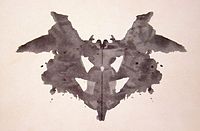Rorschach inkblot test
| Rorschach test | ||||||||||||||
|---|---|---|---|---|---|---|---|---|---|---|---|---|---|---|
| Medical diagnostics | ||||||||||||||
The first of the ten cards in the Rorschach test, with the occurrence of the most statistically frequent details indicated. The images themselves are only one component of the test, whose focus is the analysis of the perception of the images.
|
||||||||||||||
| Pronunciation | (/ˈrɔːrʃɑːk/ or /ˈrɔərʃɑːk/,German pronunciation: [ˈʀoːɐ̯ʃax] | |||||||||||||
| Synonyms | Rorschach inkblot test, the Rorschach technique, inkblot test | |||||||||||||
| MeSH | D012392 | |||||||||||||
The Rorschach test is a psychological test in which subjects' perceptions of inkblots are recorded and then analyzed using psychological interpretation, complex algorithms, or both. Some psychologists use this test to examine a person's personality characteristics and emotional functioning. It has been employed to detect underlying thought disorder, especially in cases where patients are reluctant to describe their thinking processes openly. The test is named after its creator, Swiss psychologist Hermann Rorschach. In the 1960s, the Rorschach was the most widely used projective test.
Although the Exner Scoring System (developed since the 1960s) claims to have addressed and often refuted many criticisms of the original testing system with an extensive body of research, some researchers continue to raise questions. The areas of dispute include the objectivity of testers, inter-rater reliability, the verifiability and general validity of the test, bias of the test's pathology scales towards greater numbers of responses, the limited number of psychological conditions which it accurately diagnoses, the inability to replicate the test's norms, its use in court-ordered evaluations, and the proliferation of the ten inkblot images, potentially invalidating the test for those who have been exposed to them.
Using interpretation of "ambiguous designs" to assess an individual's personality is an idea that goes back to Leonardo da Vinci and Botticelli. Interpretation of inkblots was central to a game, Gobolinks, from the late 19th century. Rorschach's, however, was the first systematic approach of this kind. The ink blots were hand drawn by Rorschach.
It has been suggested that Rorschach's use of inkblots may have been inspired by German doctor Justinus Kerner who, in 1857, had published a popular book of poems, each of which was inspired by an accidental inkblot. French psychologist Alfred Binet had also experimented with inkblots as a creativity test, and, after the turn of the century, psychological experiments where inkblots were utilized multiplied, with aims such as studying imagination and consciousness.
...
Wikipedia

